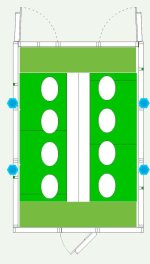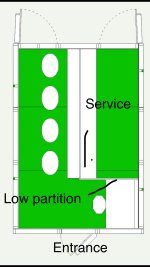Hi all, extremely keen on building a tiny tiny listening bar. I’m a visual artist and intend to transform a tiny self built pavilion into a listening bar.
The purpose: set up the bar in exhibition spaces, collaborate with artists, dj’s to concoct weird drinks menus and musical explorations.
The place is already built: 18mm plywood room (floor and walls) with a paper/wood cassette ceiling, dimensions 220x330x230 cm LWH.
It will feature a bar and 4 fixed stools, and a booth for 2. (See plan sketch)
What isn’t there: the bar, sound system, drinks&vinyl shelves etc.
My skills: sculpting, wood.
My interest: building speakers (I like large speakers in a tiny room!), to set up a weird but also nice experience for visitors. Afterwards also building some more if it turns out well.
The speakers could be built into the wall, since there is space around the pavilion, like backpacks hanging from the wall exteriors.
Almost no budget, so looking for diy or assembled parts to build with.
Curious!

The purpose: set up the bar in exhibition spaces, collaborate with artists, dj’s to concoct weird drinks menus and musical explorations.
The place is already built: 18mm plywood room (floor and walls) with a paper/wood cassette ceiling, dimensions 220x330x230 cm LWH.
It will feature a bar and 4 fixed stools, and a booth for 2. (See plan sketch)
What isn’t there: the bar, sound system, drinks&vinyl shelves etc.
My skills: sculpting, wood.
My interest: building speakers (I like large speakers in a tiny room!), to set up a weird but also nice experience for visitors. Afterwards also building some more if it turns out well.
The speakers could be built into the wall, since there is space around the pavilion, like backpacks hanging from the wall exteriors.
Almost no budget, so looking for diy or assembled parts to build with.
Curious!
Do you want large speakers just for the visual effect or is there something else you're after? If you want very low frequency response at highish levels, that needs to be part of the design.
The room is very small, and the listening distance is short. SPL that would run you (or the workers) out of the room would be easy to achieve with relatively small speakers for midrange and up.
Some of this will also come down to what you prefer in general: horn loading, "full range" designs (single driver covering the majority of the audible range), multiway, etc.
The room is very small, and the listening distance is short. SPL that would run you (or the workers) out of the room would be easy to achieve with relatively small speakers for midrange and up.
Some of this will also come down to what you prefer in general: horn loading, "full range" designs (single driver covering the majority of the audible range), multiway, etc.
Thanks! Well, large is relative in this instance, I guess. I love the looks + have enjoyed many jazz kissa visits in Japan. The music won’t be jazz only though..
Since I can implement speakers in the walls anywhere, I suppose the route of multiway w/ potentially low end placed elsewhere, can be taken?
Some horn loaded systems I’ve loved the sound of, but it is not a must of course.

This is Eonta in Matsumoto JP 🙂

This is the space (18mm plywood on wooden frames, 2200mm tall). The “loveseat” by the door at the bottom won’t benefit from the greatest sound in any case, but I nevertheless want to squeeze it in!
Since I can implement speakers in the walls anywhere, I suppose the route of multiway w/ potentially low end placed elsewhere, can be taken?
Some horn loaded systems I’ve loved the sound of, but it is not a must of course.
This is Eonta in Matsumoto JP 🙂
This is the space (18mm plywood on wooden frames, 2200mm tall). The “loveseat” by the door at the bottom won’t benefit from the greatest sound in any case, but I nevertheless want to squeeze it in!
Generally this is a good idea. As long as the cross point is low enough or the subwoofers are near the main speakers you should be OK.I suppose the route of multiway w/ potentially low end placed elsewhere, can be taken?
If you want to use horns and a low power amplifier for the main speakers, separate amplified subwoofers are also handy. You can typically get high voltage sensitivity with reasonably sized midranges/tweeters, but in the low bass range things get massive if you want high sensitivity. Modern high excursion subwoofers with high powered amplifiers can be quite small and still produce very low frequencies. Many include built-in equalization features which are also nice.
Separate subwoofers might also let you build them into the bench, counter, or loveseat. Your description makes it sound like this is going to be somewhat portable, so the more you can build in and wire essentially permanently, the better. You don't want to have to dismantle and rebuild a bunch of stuff for each move. Of course things need to be replaceable also in case of failure, so that should figure into how you build and mount things.
What about getting rid of the booth and having central bar, speakers on both sides and service, playback equip at one end or centre the array on the long axis as well and service from both ends?
Attachments
Last edited:
One afterthought about the speakers themselves. I have never heard them in the flesh but a few demo videos by Danley and others lead me to believe small synergy or unity horns might be worth checking into.
I would find it disappointing to not be able to find a 'sweet spot' for a decent stereo effect. Also, a little bass goes a long way in a small space like this...
Thanks!Generally this is a good idea. As long as the cross point is low enough or the subwoofers are near the main speakers you should be OK.
If you want to use horns and a low power amplifier for the main speakers, separate amplified subwoofers are also handy. You can typically get high voltage sensitivity with reasonably sized midranges/tweeters, but in the low bass range things get massive if you want high sensitivity. Modern high excursion subwoofers with high powered amplifiers can be quite small and still produce very low frequencies. Many include built-in equalization features which are also nice.
Separate subwoofers might also let you build them into the bench, counter, or loveseat. Your description makes it sound like this is going to be somewhat portable, so the more you can build in and wire essentially permanently, the better. You don't want to have to dismantle and rebuild a bunch of stuff for each move. Of course things need to be replaceable also in case of failure, so that should figure into how you build and mount things.
That would mean building bass into the counter at a very low height 0-100cm? Does it not get obstructed by the actual guests sitting? Or behind them in the back wall?
I could build the speakers into cabinets that can be inserted in specific openings in the wall, and unbolt/take em out when dismantling.
In that case: the bass cabs could potentially be massive, since their backs are hanging out of the actual pavilion 🙂
I’m intrigued by the unity horn concept, especially since I love to build cabinets. How to combine w the bass and positioning.. 🙂
Hey!What about getting rid of the booth and having central bar, speakers on both sides and service, playback equip at one end or centre the array on the long axis as well and service from both ends?
Well, entrance is at the bottom, and service on the right. I kinda love separation between the crowd and the barman, and the theatricality of these separate entries/exits. (the top left leads you into a large studio space and lets you discover the “backstage” of this pavilion)
So in a way the layout cannot be altered much. The loveseat is more of an idea coming from classic bars such as the Kärntner bar in Vienna by architect Adolf Loos. It’s a reference/sample 🙂
A low wall (120cm) isolates it from the service/bar area, so speakers can be above that horizontal marker anywhere.
Attachments
Not to any significant degree, as long as you keep the cross point low. 80-100 Hz is the typical crossover range for subwoofers. Below there, the sound is omnidirectional and difficult to localize. As long as you don't significantly obstruct the speaker with a solid, sealed barrier, the bass tends to just go around any humans or minor obstructions. Down-firing subwoofers are a good example of this in home audio.Does it not get obstructed by the actual guests sitting?
Just a thought: keep in mind customer and employee (if there are any) safety. I know some local labor safety regulations and the max allowed continuous "background" music spl is quite low.
For example in most of the local clothing retail shops the music is waaay to loud.
For example in most of the local clothing retail shops the music is waaay to loud.
This fits with what I was thinking about the unity/synergy horn - That (as far as I know) they are very focused/coherent so that change in distance at low volume won't matter much. 'Never built them though so this is just guessing.
A couple of video examples that impressed me. One. Two. There are quite a few other examples on YouTube. I imagine you could optimize the design for your booth .
A couple of video examples that impressed me. One. Two. There are quite a few other examples on YouTube. I imagine you could optimize the design for your booth .
Last edited:
- Home
- Loudspeakers
- Multi-Way
- Micro-listening bar project


